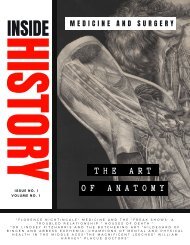Inside History: Protest. Revolt & Reform
For our next issue we take a closer look at the theme of Protest from the events of Peterloo to the fall of the Berlin. Inside we cover a whole range of historical protests and the individuals who led the charge for change. This issues includes: John Brown's raid on Harpers Ferry, The Suffragettes, Billie Holiday and the role music has played in protests, The Civil Rights Movement, Protest and Sport, We are the People: The Fall of the Berlin Wall, Bloody Sunday at Trafalgar Square, and much much more.
For our next issue we take a closer look at the theme of Protest from the events of Peterloo to the fall of the Berlin. Inside we cover a whole range of historical protests and the individuals who led the charge for change. This issues includes:
John Brown's raid on Harpers Ferry, The Suffragettes, Billie Holiday and the role music has played in protests, The Civil Rights Movement, Protest and Sport, We are the People: The Fall of the Berlin Wall, Bloody Sunday at Trafalgar Square, and much much more.
- No tags were found...
You also want an ePaper? Increase the reach of your titles
YUMPU automatically turns print PDFs into web optimized ePapers that Google loves.
"I know you will sentence me, but it will not make much
difference…I am really a happy and grateful woman
because I have been able to live in a century in which Mrs
Pankhurst was, and in some slight measure I have tried to
carry out what I believe in. It matters not what becomes of
me in the future."
Mary Richardson, Manchester Courier and Lancashire
General Advertiser – Friday 13 March 1914
In October 1903, at a table in an
unassuming parlour in the house of a
middle-class widow from Manchester,
the Women’s Social and Political Union
(WSPU) was formed. ‘How long you
women have been trying for the vote,’
Christabel Pankhurst had said to her
mother Emmeline, ‘For my part, I mean to
get it.’ Christabel, along with Oldham
suffragette Annie Kenney, instigated the
first act of disruption in 1905 at the Free
Trade Hall in Manchester, thus launching
a militant campaign that would send a
battle cry across the nation, for women
to rise up, and fight back. The eyes of
Britain homed in on the movements of
Emmeline Pankhurst, the general at the
helm of the army, but as her recurring
arrests repeatedly made headlines, the
women who acted in her name were too
great in number to be suppressed.
It is little wonder that the militancy of the
WSPU did, and indeed, has continued to,
captivate audiences and take a place in
public memory. The violence employed
by the WSPU, alongside the almost
mythologised status of leader Emmeline
Pankhurst, was at the heart of the 2015
film Suffragette, and for the most part,
the 2018 centenary celebrations marking
100 years since the Representation of
the People Act was passed, and some
women were finally afforded the vote.
Acts of arson and bombings escalated
between 1912 and 1914; prior to this,
attacks on government ministers and
acts of disruption were much more
common. The more the government
resisted giving women the vote, and the
more hopes were lifted then dejected by
the cycle of Conciliation and Franchise
Bills that were brought into Westminster
before being voted down, the harder the
WSPU intensified their actions. Growing
in scale and impact, arson attacks were
directed towards public spaces such as
the refreshment pavilion at Kew
Gardens, which was burned to the
ground in February 1913, at the hands of
Olive Wharry and Lilian Lenton (perhaps
the slipperiest and most evasive
suffragette known to the police). Later in
1913, Kitty Marion’s explosive work in
Liverpool left £30,000 worth of damage
at Seafield House. The bomb she had left
in Sefton Park’s palm house did not
detonate, but a similar attack in
Manchester’s Alexandra Park reduced
the glass house there to rubble.
It is easy to imagine why public spaces
like the elegant pavilions and glass
houses attracted the WSPU. Whilst
interrupting public meetings and
attacking individuals had proven
affective, the window smashing
campaign of 1912 had provided them
with an allegory that held more agency,
and prompted more genuine public fear,
than their previous campaigns. The idea
that broken windows should be more
defended than the rights of women
resonated far beyond the targeted area
of London’s West End. Destruction of
property – whilst easily reversable in
many instances – was a
physical representation of the suffering
that women were consistently put
through, a symbol of their constant
political struggle – the bills thrown out of
parliament – something built up only to
be destroyed. In this war, there were
casualties, and for once the casualties
were on the opposing side, and not
simply with the force-fed or hunger
striking suffragettes imprisoned over
enemy lines.
As a curator who has worked in
museums and historic houses for most
of my career, the attacks on public
cultural spaces and paintings are
something of interest to me. Today,
museums and galleries embrace the
different functions and contexts it holds
for different audience members and
seeks to converse more openly and
create a back and forth with its visitors
and communities around it. In 1913,
however, the role of public spaces, like
the glass house at Sefton Park, and
indeed as we will soon arrive at,
Manchester Art Gallery, functioned in an
entirely different way. Whilst public
gardens and parks had changed how
working and middle-class people were
able to spend their leisure time and (in
urban areas) enjoy green space,
museums and galleries drew in less
diverse audiences in comparison to
outdoor spaces. Still, as public art
became more accessible, it too became
a target for the WSPU.
There are some considerations to make
here on the public spaces – and more
significantly, cultural property - that the
WSPU would target in their campaigns
of retaliation and destruction. Some
paintings, like the infamous Rokeby
Venus, were bought by public funds and
donations are therefore
representations of public property, just
as much as the glass houses of
Liverpool and Manchester were, and so
the very real fear of attacking precious
paintings on display in public galleries
caused great concern.
After the bombing of the Kew Gardens
Pavilion, other cultural spots, such as
the State Apartments at Windsor,
closed entirely or put in extra measures
to prevent attacks, causing more
disruption by creating more economic
losses. Certain objects – such as muffs,
40 INSIDE HISTORY

















